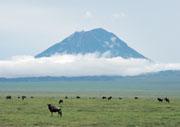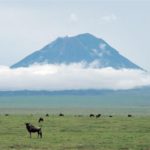Tanzania doesn’t only contain Africa’s highest mountain, largest lakes and biggest game reserve – it also has some of the best food on the continent
GWYNNE CONLYN
Its three large islands – Pemba, Unguja (the home of Zanzibar) and Mafia – are still known as the Spice Islands. One of Tanzania’s charms is, of course, Mount Kilimanjaro, often seen peeping through the clouds as you fly over it. At 5 895m, it is the highest mountain in Africa, and its mate Meru doesn’t fall far short of this at 4 566m. The large number of visitors who attempt to climb these giants each year does not, however, come close to the number that visit the country’s other famous attraction – its abundant animal life in enormous, unspoilt reserves.
Tanzania contains more government-protected land devoted to game reserves and national parks than any other single country in the world. Best known is the Serengeti National Park, which stretches over 14 763km2, making it the largest nature reserve in a single country. A world heritage site as well as one of the world’s seven natural wonders, Serengeti means “without borders”, or “endless area” and that’s exactly what it looks like from both land and air (by plane or hot-air balloon, a marvellous way to see it).
Offering heart-stopping beauty and one of the most abundant animal populations in the world, the Serengeti is renowned for its annual wildebeest migration. Between December and July, millions of hooves hammer the plains as zebra and antelope join the wildebeest in their move to new grazing land, while predators gather to pick up those that fall behind. One of the best places from which to watch this spectacle is the recently opened Bilila Lodge. Like the few other lodges permitted in this reserve, it is built to maintain the integrity of the land.
Its design follows nature’s colours and lines, in fact it almost disappears into the landscape until one arrives at the magnificent front entrance, where Masai warriors stand sentinel, peering proud and silent into the distance. Adjoining the Serengeti National Park in the northern part of the country is another wonder, the Ngorongoro Crater, a volcanic phenomenon surrounding a deep bowl that overflows with mountain forests, rivers, waterfalls, ancient archaeological sites and wildlife. Visitors to Tanzania usually want to combine a “bush and beach” experience, and the ideal place for this is Saadani National Park, the only East African wildlife sanctuary with an Indian Ocean coastline.
On this coast, with the warm ocean lapping at its feet, is Saadani Lodge, winner of British Elle magazine’s 2008 Chic Shack awards and named one of The Guardian’s 10 Best Safari Holidays. It is owned by passionate environmentalist Costa Coucoulis, a Burundian who moved here eight years ago because he had heard that elephants swim in the sea at Saadani. This may or may not be true, but herds are sometimes spotted strolling on the beach, along with many other animals more commonly seen inland. Wildlife proliferates in the Saadani National Park, both on and offshore. Turtles and dolphins are often seen in the clear waters around the sand island near the beach. While floating in the sea at sunrise (an almost obligatory activity) all the coastline that can be seen in either direction is part of the reserve.
As for food, nutrients rich in this stretch of sea attract prawns and other seafood, which make a constant “without borders”, or “endless area” and that’s exactly what it looks like from both land and air (by plane or hot-air balloon, a marvellous way to see it). Offering heart-stopping beauty and one of the most abundant animal populations in the world, the Serengeti is renowned for its annual wildebeest migration. Between December and July, millions of hooves hammer the plains as zebra and antelope join the wildebeest in their move to new grazing land, while predators gather to pick up those that fall behind. One of the best places from which to watch this spectacle is the recently opened Bilila Lodge.
Like the few other lodges permitted in this reserve, it is built to maintain the integrity of the land. Its design follows nature’s colours and lines, in fact it almost disappears into the landscape until one arrives at the magnificent front entrance, where Masai warriors stand sentinel, peering proud and silent into the distance. Adjoining the Serengeti National Park in the northern part of the country is another wonder, the Ngorongoro Crater, a volcanic phenomenon surrounding a deep bowl that overflows with mountain forests, rivers, waterfalls, ancient archaeological sites and wildlife. Visitors to Tanzania usually want to combine a “bush and beach” experience, and the ideal place for this is Saadani National Park, the only East African wildlife sanctuary with an Indian Ocean coastline.
On this coast, with the warm ocean lapping at its feet, is Saadani Lodge, winner of British Elle magazine’s 2008 Chic Shack awards and named one of The Guardian’s 10 Best Safari Holidays. It is owned by passionate environmentalist Costa Coucoulis, a Burundian who moved here eight years ago because he had heard that elephants swim in the sea at Saadani. This may or may not be true, but herds are sometimes spotted strolling on the beach, along with many other animals more commonly seen inland. Wildlife proliferates in the Saadani National Park, both on and offshore. Turtles and dolphins are often seen in the clear waters around the sand island near the beach. While floating in the sea at sunrise (an almost obligatory activity) all the coastline that can be seen in either direction is part of the reserve.
As for food, nutrients rich in this stretch of sea attract prawns and other seafood, which make a constant feast for the dining table. Saadani’s restaurant (elevated above the sea on stilts) serves freshly caught lobster and the largest, sweetest prawns, prepared simply with lemon and lime and a splash of piri piri, along with fluffy jasmine rice and crisp salad containing the most marvellous tomatoes I’ve ever tasted. This fertile country grows some of the continent’s finest vegetables, as can be seen at the markets, where the juicy, rich-red tomatoes in particular have that rare, sweet, real-tomato taste, and there are more varieties of garlic than most cooks ever see. Tanzanian cuisine does not include much meat, but focuses instead on beans, corn, rice, cassava and wheat as staples. Growing in profusion are nuts, coconuts, mangos, bananas and plantains.
Eating habits have been influenced by ancient historic influences, such as the Persians, who introduced rice. This is still the main ingredient in many dishes, flavoured with Zanzibar’s legendary chillies, cinnamon and cloves. Dodoma is the country’s official capital, but Dar es Salaam (which means “Haven of Peace”) remains the largest trading centre, with a bustling harbour, fish market and a fresh produce market on the outskirts of the city. Remnants of colonial presence, both German and British, can be seen in the landmarks and architecture around the city.
A walking tour of the city takes in St Joseph’s Cathedral, the old State House, the National Museum, Village Museum and the excellent craft market. Then, of course, there is the food. About nine kilometres from the city centre is the suburban rooftop restaurant, Addis in Dar, which serves Ethiopian cuisine. The chairs are low and the tables look like egg cups. This is because they are designed to hold a large dish lined with injeri (Ethiopian flatbread) which fits into the hollow tabletop. The spicy, aromatic and mostly vegetarian dishes are upended one by one onto the large injeri, then scooped up and eaten with smaller rolls of injeri. At the end of the meal, the injeri that has been used as a base has soaked up a whole array of delicious juices, and is irresistible.
Hand-washing equipment is provided before and after the meal. With a glass of honey wine, this was one of the best meals I had in Dar. (And you don’t even have to go there to taste it, because sister restaurant Addis in Cape has just opened in Cape Town.) For a more formal experience, the Oriental in the upmarket Kilimanjaro Hotel serves mostly seafood with Asian-inspired flavours, and lobster is surprisingly inexpensive (more or less the same price as chicken on the menu).
Brunch in the gorgeous secret garden at the back of the hotel is popular, as are sundowners in the topfloor bar, overlooking the lagoon and the city’s islands. In the northern highlands of the country, nestling between the twin peaks of Meru and Kilimanjaro, is beautiful Arusha. The town clock is said to mark the exact halfway point between Cape Town and Cairo, and the city has two particularly excellent restaurants.
Not far from the clock, South African-born chef Mary Chatzifotiadi owns and runs the Bay Leaf Fine Dining Restaurant, an unexpected culinary discovery where there is always top-notch cuisine on the menu. On the outskirts of Arusha, a Michelin-starred Belgian chef mans the kitchen of Onsea House, a brasserie serving inventive dishes that combine African and European tastes and techniques.
Coffee fans will love freshly ground Tanzanian coffee, served in small porcelain cups by street vendors, but it is chai (the almost universal word for tea) that is most widely consumed here. Made with cardamom, ginger and cinnamon, it is the perfect end to a perfect meal. One thing to remember, wherever you happen to be eating in Tanzania, is the unofficial national slogan, “pole pole”. Pronounced paw-lay paw-lay, it means “slowly-slowly”. So don’t let leisurely service upset you. As the locals say with a smile, “You have the watch, we have the time.”
• Bilila Lodge: Call +255-22-213-1111 or email reservations.bililalodge@ kempinski.com
• Saadani Lodge: Call +255-22- 277-3294, email reservations@ saadanilodge.com or visit www. sanctuaryretreats.com
SOURCES
ANNIE BIRCH and GWYNNE CONLYN






